The Takayama festivals in Takayama City, Gifu Prefecture are held twice a year. The Sanno festival held on April 14 and 15 celebrates the deity of Hie Jinja Shrine(日枝神社). The shrine parishioners live in the southern half of the former Takayama Town. The Hachiman festival held on October 9 and 10 celebrates the deity of Sakurayama Hachimangu Shrine(桜山八幡宮). The shrine parishioners live in the northern half of the former Takayama Town.
On the afternoon of the 14th, the procession including mikoshi(portable shrine), people in historical costumes, performers, musicians starts from the Hie Shrine and arrives at the Otabisho(御旅所). Otabisho is a rest house for the god or place where the sacred palanquin is lodged during a festival. On the afternoon of the 15th, the procession returns to the shrine.
 |
| Festival parade by robertpaulyoung /flickr |
Mikoshi(portable shrine) at the autumn festival
 |
| Festival parade by robertpaulyoung /flickr |
Mikoshi(portable shrine) at the spring festival
 |
| Festival parade by robertpaulyoung /flickr |
 |
| Spring Festival Parade by pauldesu.com /flickr |
 |
| Spring Festival Parade by pauldesu.com /flickr |
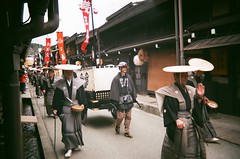 |
| Takayama Festival by Yuya Tamai /flickr |
Kamishimo is the combination of a sleeveless jacket called 'Kataginu' and trousers(or skirt) called 'Hakama'. They are wearing kamishimo over a kimono.
 |
| Festival parade by robertpaulyoung /flickr |
Tokeiraku(闘鶏楽) :
Tokeiraku(闘鶏楽) literally means cockfighting music. People dressed as chickens dance while ringing bells.
 |
| Festival parade by robertpaulyoung /flickr |
Tokeiraku(闘鶏楽)
 |
| Festival parade by robertpaulyoung /flickr |
Lion dance(獅子舞)
the procession
 |
| Spring Festival Parade by pauldesu.com /flickr |
 |
| Festival parade by robertpaulyoung /flickr |
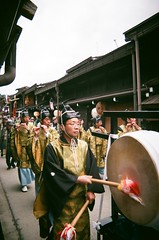 |
| Takayama Festival by Yuya Tamai /flickr |
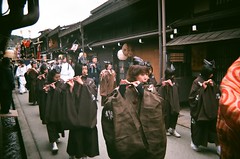 |
| Takayama Festival by Yuya Tamai /flickr |
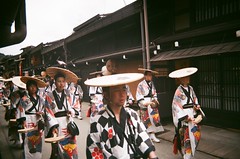 |
| Takayama Festival by Yuya Tamai /flickr |
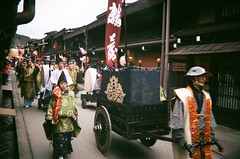 |
| Takayama Festival by Yuya Tamai /flickr |
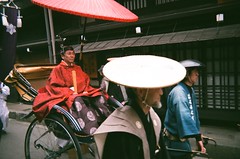 |
| Takayama Festival by Yuya Tamai /flickr |
The festivals feature spectacular festival floats: 12 floats at the spring festival, and another 11 floats at the autumn festival. The float is called yatai in Takayama. It's also called "Moving Yomeimon(陽明門, a gate of Toshogu in Nikko)" because of its gorgeousness.
Four of 12 floats are drawn to the plaza in front of Otabisho on the 14th and the 15th. The main feature of the Sanno festival is marionette shows performed on three of them on the 14th and the 15th. Five or six puppeteers in the float move marionettes on the float by manipulating 20-30 strings twice both in the morning and the afternoon.
It is said that the first float in Takayama appeared at the Hachiman Festival in 1708. At the Sanno Festival, the first float appeared around 1751. Most of the floats appearing in the festivals were made in the Edo Period and were repaired a few times.
 |
| Marionette performance by robertpaulyoung /flickr |
 |
| IMG_5510 by chinogypsie /flickr |
1) Sanbaso doll takes a bell for Kagura with his right hand and a fan with his left hand.
2) He looks up after putting his head over a box.
3) He is wearing the mask of Okina(old man) . He performs a noh dance.
 |
| IMG_5491 by chinogypsie /flickr |
Syakkyotai(石橋台) float with a marionette at the spring festival
1) A woman dances with a folded fan in her hand.
 |
| Marionette performance by robertpaulyoung /flickr |
 |
| Marionette performance by robertpaulyoung /flickr |
2) The woman turns into a lion and performs the lion dance.
3) The lion turns into the woman again.
Ryujintai(龍神台) float with marionettes at the spring festival
1) A karako(Chinese child) appears with a pot.
 |
| Marionette performance by robertpaulyoung /flickr |
 |
| Marionette performance by robertpaulyoung /fllickr |
2) Red-faced Dragon God appears out of the pot while scattering confetti.
Other floats are drawn to Kawahara-machi on the 14th, and to Hon-machi and the Sanmachi Street on the 15th.
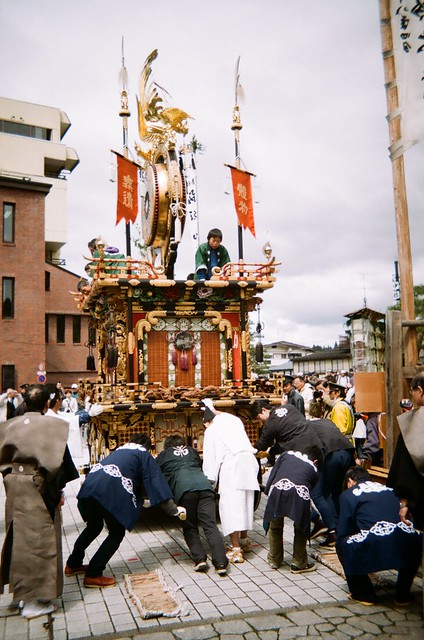 |
| Takayama Festival by Yuya Tamai /flickr Kaguratai(神楽台) |
Kaguratai(神楽台) is the head of the floats. A Japanese dram is placed on the float.
A float named Hoteitai(布袋台) was made around 1718. This float appears in the autumn festival. Each of two Chinese children makes a jump from one bar to another. Then each makes a jump from the fifth bar onto the shoulder of Hotei(布袋). They perform a spectacular feat. Hotei was modeled on a Chinese monk.
 |
| Hotei. YOU BASTARD. by dean blackburn /flickr (A Chinese child is standing on the left shoulder of Hotei) |
 |
| Festival float by robertpaulyoung /flickr Seiryutai(青龍台) |
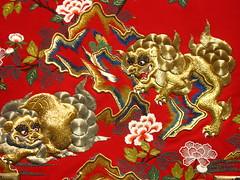 |
| embroidery on festival cart by randomidea /flickr (Japanese famous painter Maruyama Okyo(円山 応挙,1733-1795) drew a rough design for this embroidery on Gotaisan(五台山) float.) |
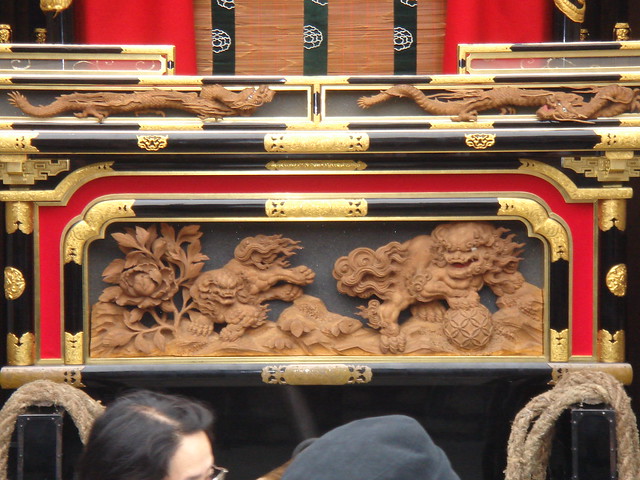 |
| takayama11 by Flowizm /flickr (sculpture of Syakkyotai made in 1865) |
 |
| Festival float by robertpaulyoung /flickr (sculpture of Ryujintai(龍神台) made in 1968) |
The festival floats have exquisite wood sculptures on them.
As Hida area only had poor soil, its residents couldn't pay tribute such as rice, local products to the Imperial Court. Instead, tax was paid in the form of labor. Hida was a mountainous area, so many woodsmen and carpenters lived there.
 |
| Festival float by robertpaulyoung /flickr (sculpture of Ebisutai made in 1848) |
Around 100 young men were engaged in construction work in Nara or Kyoto every year for about 500 years. They acquired excellent woodworking skills, and they gained a greater reputation from the 8th to the 9th centuries.
 |
| Festival float by robertpaulyoung /flickr (sculpture of Kirintai(麒麟台) made in 1845) |
Hida was under the direct control of the Edo Shogunate in 1652. Local governors from the shogunate administered the affairs of state at Takayama Jinya(高山陣屋).
Hida has little suitable land for cultivating rice. Most of suitable land for cultivating rice was sold under foreclosure to wealthy merchants. They made a great fortune by lending money to farmers, woodsmen, even feudal lords. Common people were besieged by a serious famine and lived in dire poverty. The local governors often misallocated rice for the residents. A large-scale peasants'revolt continued for about 20 years in the Edo Period.
Meanwhile, the wealthy merchants paid a lot of money for infrastructure building and rescued needy persons in a flood disaster and famine. Some people say that they put their efforts into making gorgeous floats to focus people's attention on the festivals.
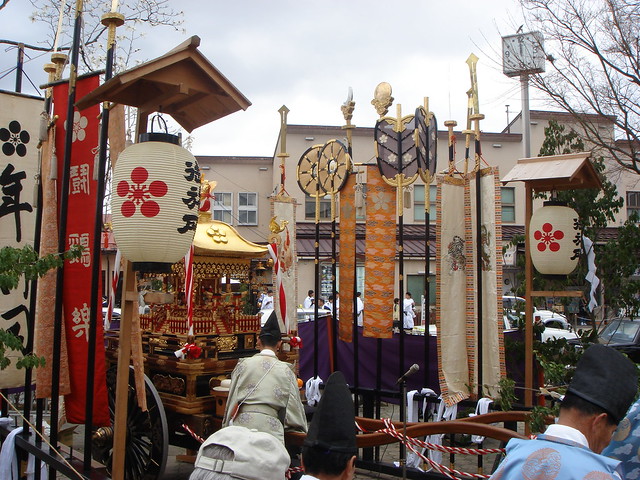 |
| takayama1 by Flowizm /flickr |
 |
| Takayama by robertpaulyoung /flickr |
On the night of the 14th, each float is spectacularly decorated with around 100 lanterns.
 |
| Float procession by robertpaulyoung /flickr Seiryutai(青龍台) at the spring festival |
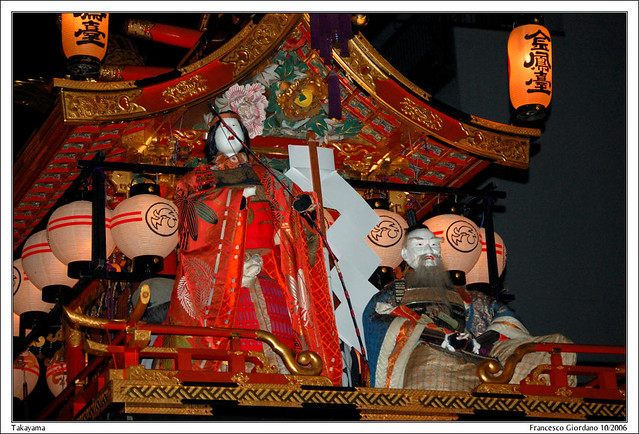 |
| 031_takayama07 by Francesco_G /flickr Kinpotai(金鳳台) at the autumn festival |
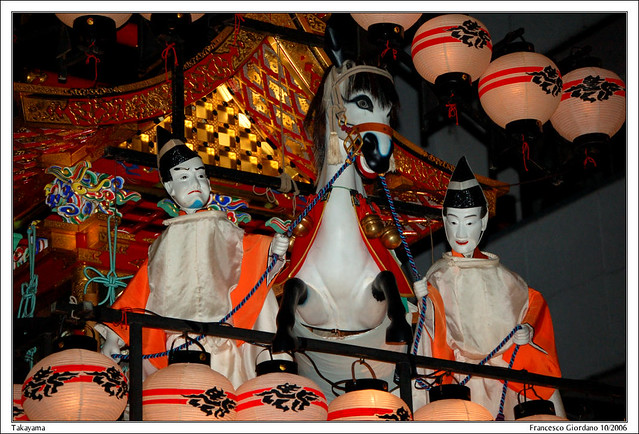 |
| Takayama by Francesco_G /flickr Jinma-tai(神馬台) at the autumn festival |
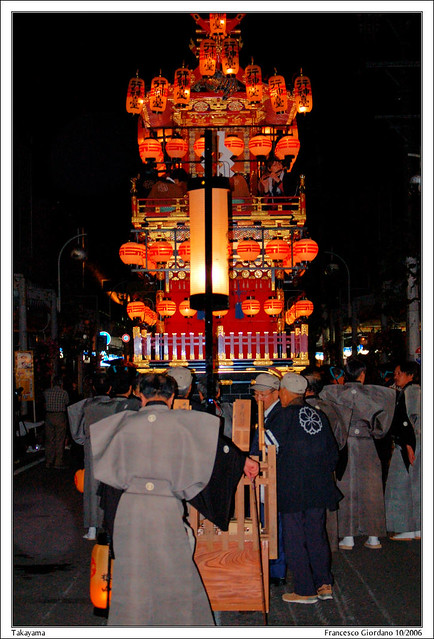 |
| Takayama by Francesco_G /flickr Gyojintai(行神台) at the autumn festival |
 |
| Takayama Spring Festival by pauldesu.com /flickr Hootai(鳳凰台) at the spring festival on April 14 |
 |
| Takayama Spring Festival by pauldesu.com /flickr
yataigura for Ebisutai(恵比須台)
|
Yataigura(屋台蔵, storehouses for the festive floats)
 |
| Float store house by robertpaulyoung /flickr |
There are several dozo(土蔵) storehouses for the festive floats in Takayama. Dozo are traditional Japanese architectural structures with outer walls made of mud and finished with plaster. They are highly fire‐resistant. After the great fire in 1833, dozo storehouses for the floats were built one after another. Dozo are still protecting the floats from a fire.
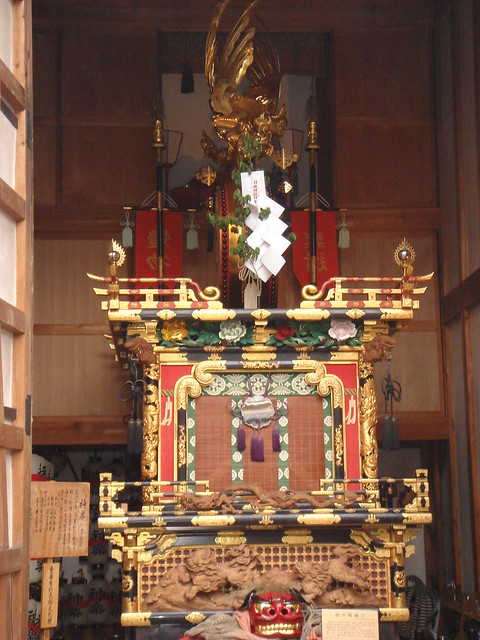 |
| takayama9 by Flowizm /flickr yataigura for Kaguratai(神楽台) |
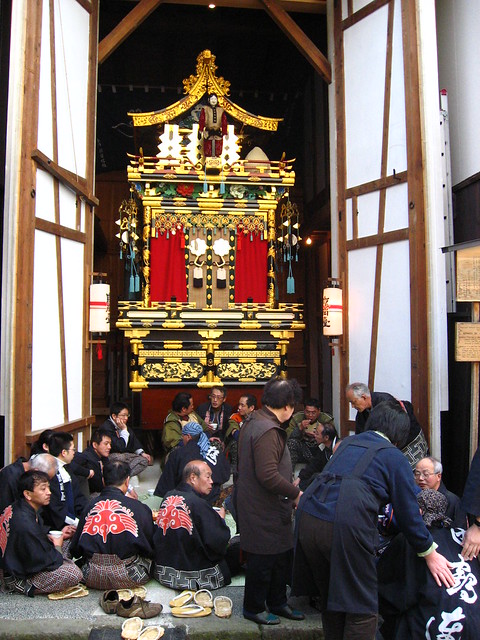 |
| festival cart caretakers relax by randomidea /flickr yataigura for Konkotai(崑崗台) |
No comments:
Post a Comment